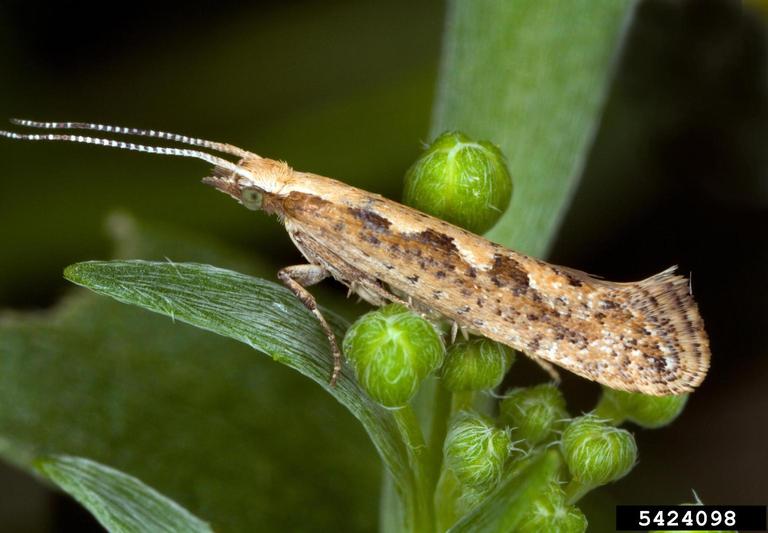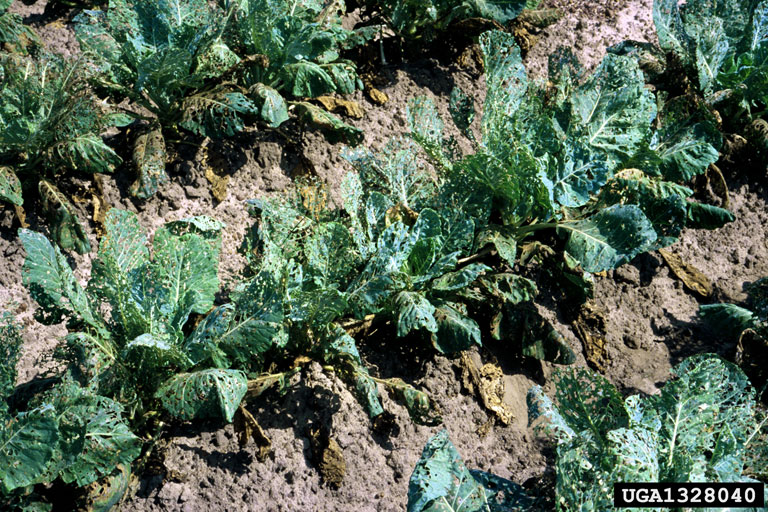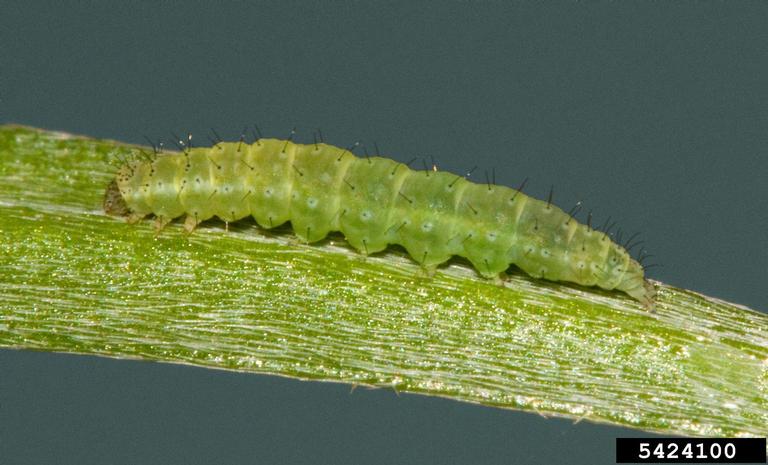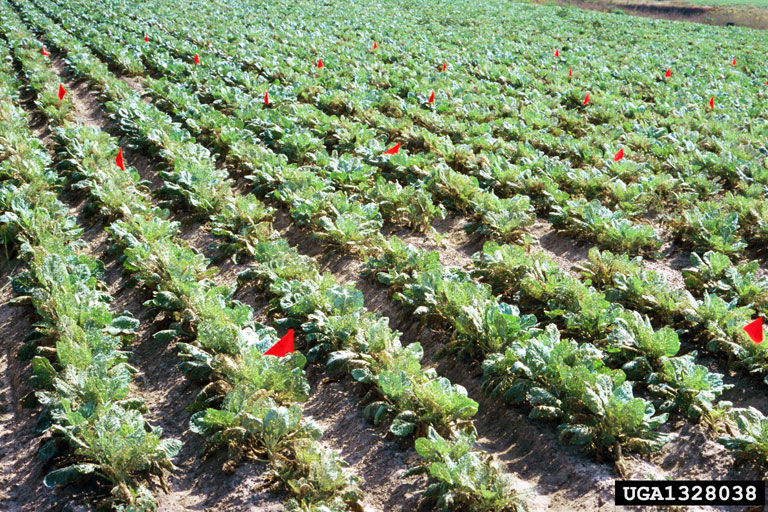Trying to control the diamondback moth on brassica crops can be a major challenge, especially in those areas where crops are produced year-round.

Diamondback moth (Plutella xylostella L.) is considered to be the most damaging pest of brassica crops worldwide. Growers of brassica crops, including cabbage, broccoli, cauliflower, kale, Brussel sprouts and collards, are very familiar with the plant damage done by this devastating pest. It costs growers worldwide as much as $5 billion annually. The moth, which has been found in every state, can infest both controlled environment and field crops.

Damage from diamondback moth
University of Georgia entomologist Alton Sparks Jr. has been dealing with diamondback moth for over 30 years.
“The primary crops Georgia growers have problems with diamondback moth (DBM) are cabbage and collards,” Sparks said. “The state is also seeing an increase in broccoli acreage, which can also become infested by DBM. The moth has a preference for certain brassica species. Mustard greens and turnip greens also become infested with the moth, but not near the levels of infestation that occurs with cabbage, broccoli and collards.”
The larvae are the most damaging stage of the insect.
“When there are DBM infestations on brassica crops, the feeding larvae create holes in the leaves,” Sparks said. “They don’t eat that much, but even a few holes can make the plants unmarketable. Potential contamination is also a problem.
“The adult moths fly in and around the fields and there can be a lot of them. The moths aren’t directly a part of the problem other than they are laying the eggs. The eggs are almost undetectable if someone is not specifically looking for them. With broccoli the larvae and pupae can be an issue. If the larvae crawl up into the broccoli florets to pupate, they can become a contaminant when the crop is harvested.”
Identifying effective controls
Brassica crop growers in Georgia have access to numerous insecticides with different modes of action that have been labeled for use against diamondback moth.
“Georgia growers probably have 10 or more different modes of action that they can potentially use against diamondback moth,” Sparks said. “Unfortunately there is some resistance to every mode of action in Georgia. It’s kind of unique and it makes controlling the moth a real challenge.”
Sparks was involved with collecting IR-4 Project efficacy trial data for the insecticide novaluron.

“These efficacy trials were conducted on small plots at the university research station,” he said. “Although none of the IR-4 trials were conducted in commercial fields, the growers are very supportive of the research. With Section 18 registrations growers support the research by allowing us to do trials in their fields.
“Most requests to IR-4 for the registration of insecticides for minor crop use come from researchers, but the growers support our research activities and indirectly support those requests through that work.”
When Sparks conducted the research on novaluron he did between four to six efficacy trials on diamondback moth a year.
“Because I’m with the extension service, usually by the time I receive an insecticide to trial, it’s relatively close to registration,” he said. “I continue to work with these products even after they receive registration. I generally don’t get a product to trial more than one to two years before it’s registered.”
University of Florida entomologist Dakshina Seal has been doing research with novaluron since 1995. Although he did not conduct trials with the insecticide for IR-4, he has studied its effectiveness on controlling diamondback moth on cabbage. Like Sparks, Seal conducted efficacy studies in small plot trials at the university’s research station.
“In the area of south Florida where I’m located, there is a small acreage of commercial brassica crops,” Seal said. “However, in northern Florida there are several thousand acres dedicated to brassica crop production where diamondback moth can be a major problem.
“For the trials I did with novaluron I was trying to control diamondback moth on cabbage. In this area the moth is the number one pest on cabbage.”
Avoiding pesticide resistance
Sparks said Georgia brassica growers are trying to practice integrated pest management when it comes to controlling diamondback moth, but year-round production impacts the effectiveness of their efforts.
“If growers have brassica crops in the ground, they need to be scouting for diamondback moth,” Sparks said. “The vast majority of our vegetable acreage is scouted relatively closely. Large growers have people who scout for them and some hire commercial scouts. Many of the extension county agents do a lot of work helping growers identify the moth and potential problems.”

Seal said intercropping with other crops other than Brassica species is an effective method for breaking the insect life cycle.
Sparks constantly tells growers that they should have a host-free period in the middle of the summer.
“There is some crop rotation and separation to break the pest cycle, but I wish growers could implement a host-free period,” Sparks said. “Some small growers who are growing year round are planting in close proximity to their prior crop, which is not a good thing. About 90 percent of the cabbage grown in Georgia is produced in two counties. This makes it hard to get a lot of separation between crops from field to field when it’s in a relatively small area.”
Sparks said growers have gotten better at destroying plant residues, which can provide the moth with a food source after crops are harvested.
Effective insecticide use
Sparks said one of the things growers are doing to maintain control of the moth is to rotate the modes of action.
“We work with growers to identify moth populations in individual fields,” Sparks said. “We collect the populations and test the moths against multiple modes of action to find out which modes of action will work best in a given field.”
Seal said applications of insecticides have to start early before the larvae crawl into the head of the cabbage so that they can contact the insect.
“Most large growers treat on a field-by-field basis,” Sparks said. “Sometimes it’s on a farm-by-farm basis if the growers have four or five farms in multiple counties. With vegetables growers applications are made once or twice a week depending on the pest pressure and time of year. In most cases, the insecticides and fungicides are applied as necessary.
“One of the challenges in Georgia is growers can produce year round which allows pests to develop year round. This is a great area to grow vegetables, but it is also a very challenging area.”
Growers are also using biopesticides like Bacillus thuringiensis to control the moth.
“Growers use a tremendous amount of Bt, but they have seen some resistance to Bt strains as well,” Sparks said. “Growers are more likely to apply Bt when pest pressure is low and they don’t need a highly efficacious product. Applying Bt can reduce the selection pressure for resistance to other chemical controls.”
Sparks expects more products will become available to minor crop growers.
“Previously obtaining minor-use registrations through IR-4 was critical for the vegetable industry,” Sparks said. “There have been some changes in the registration process so the chemical companies have been more interested in registering products and putting minor uses on their labels. Registrants have been more open to registering their products for minor use crops. Working with IR-4 is still a very critical part of being able to build the growers’ tool box for pest management with these crops.”
For more:
Alton Sparks Jr., University of Georgia, College of Agricultural and Environmental Sciences, Tifton, GA 31793; asparks@uga.edu
Dakshina Seal, University of Florida, Tropical Research and Education Center, Homestead, FL 33031; dseal3@ufl.edu
PR# 09041 , 09042 Brassica (Diamondback Moth) , PR#12661 (Leafy Greens) , PR# 12662 (Brassica, Head & Stem) , PR# 08420 (Mustard Greens), PR# 09745 (Swiss Chard)
David Kuack is a freelance technical writer in Fort Worth, Texas; dkuack@gmail.com.
